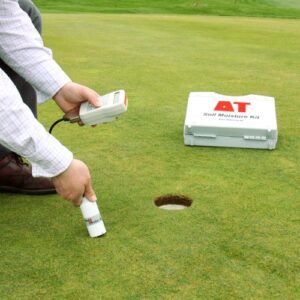Bowls green surface firmness is something we know about instinctively as greenkeepers, but do we fully understand its impact on the development of a Performance Bowling Green?
Last time we discussed smoothness and trueness and the effect these have on bowls green performance, but it was clear from this that we were still dealing primarily with symptoms and not causes.
To get closer to a clear understanding of what makes a good or bad green surface, we have to move on to the second level of our hypothesis. You might recall that the hypothesis offered was as follows:
- Bowling Green Surface Trueness and Smoothness are correlated with green surface firmness (firmer greens are smoother and truer).
- Bowling Green surface firmness is correlated with soil moisture content (wetter greens are less firm).
- Soil Moisture Content is correlated with Soil Organic Matter Content
- Therefore the Performance of Bowling Green Surfaces is correlated with Soil Organic Matter Content.
Measuring Bowls Green Surface Firmness
For smoothness and trueness measurement, we saw last time that the turf industry has had to get inventive, with the development of equipment like the STRI trueness meter and the Parry Meter.
In contrast, the measurement of bowls green surface firmness can rely on some tried and tested technology in the shape of the Clegg Hammer, a tool that is widely used for surface hardness measurement in a variety of engineering contexts such as road building.
Using the Clegg Hammer to Measure Bowls Green Surface Firmness
The Clegg Hammer is in effect just an open tube which is placed with one end resting on the surface and a weight that is dropped through the tube to impact the ground. By adding some clever electronics, the instrument can measure the deceleration of the weight as it impacts the surface. In a confusion of the English language, we are measuring how quickly the weight slows down! The weight slows down and stops more slowly on a soft surface due to the give in the surface. A firmer surface will result in quicker deceleration; the weight will come to a stop more quickly. We can easily imagine this as greenkeepers as we can envisage how a heavy weight dropped on soft turf would continue into the turf for some way.
Clegg + Moisture Meter
For engineering use the Clegg hammer might well be used in isolation to gauge surface hardness. In our quest to measure bowls green surface firmness we are trying to see if there is a correlation between surface firmness and moisture content. With this in mind we also take soil moisture readings from the turf adjacent to the spots where we take the Clegg hammer readings. We use a very accurate moisture meter called a Theta Probe which gives a reading for soil moisture as a percentage of Field Capacity.
The Clegg Hammer gives us a reading in Gravities (gm) and a higher reading corresponds with a firmer surface.
In recent projects I undertook with some of my students in Southern China, our Clegg and Moisture readings on 3 different golf greens produced the graph below:

Although there isn’t a lot of Data here, we can already see that there is quite a clear correlation between soil/turf moisture content and surface firmness. The data suggests that as moisture content increases then green firmness reduces.
What is also interesting, is that green surface smoothness and trueness reduce in line with the reduction in firmness and we know that this affects green performance.
So firmer greens perform better in terms of trueness, smoothness and speed.
More Symptoms
The eagle eyed and owl eared among you will know what’s coming next; firmness is simply a symptom of moisture content, so we still haven’t drilled down to a root cause, something we can hang our hats on when searching for green performance clues. We’ll conclude the testing of our hypothesis next time and get right down to the root cause of poor surface performance on many bowling greens.




